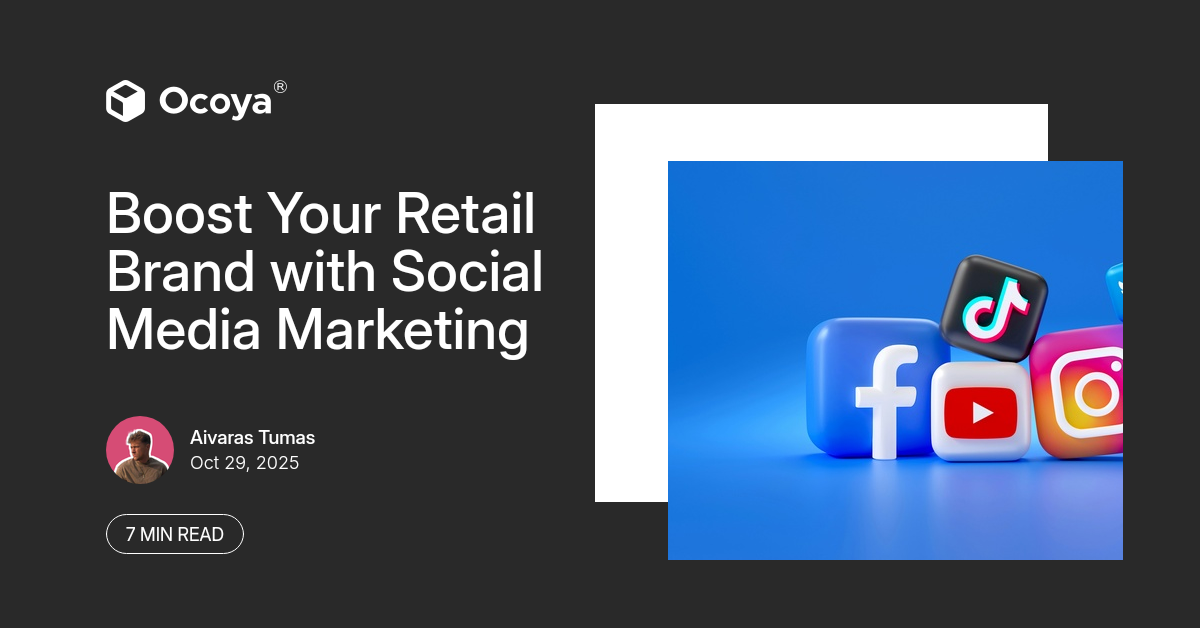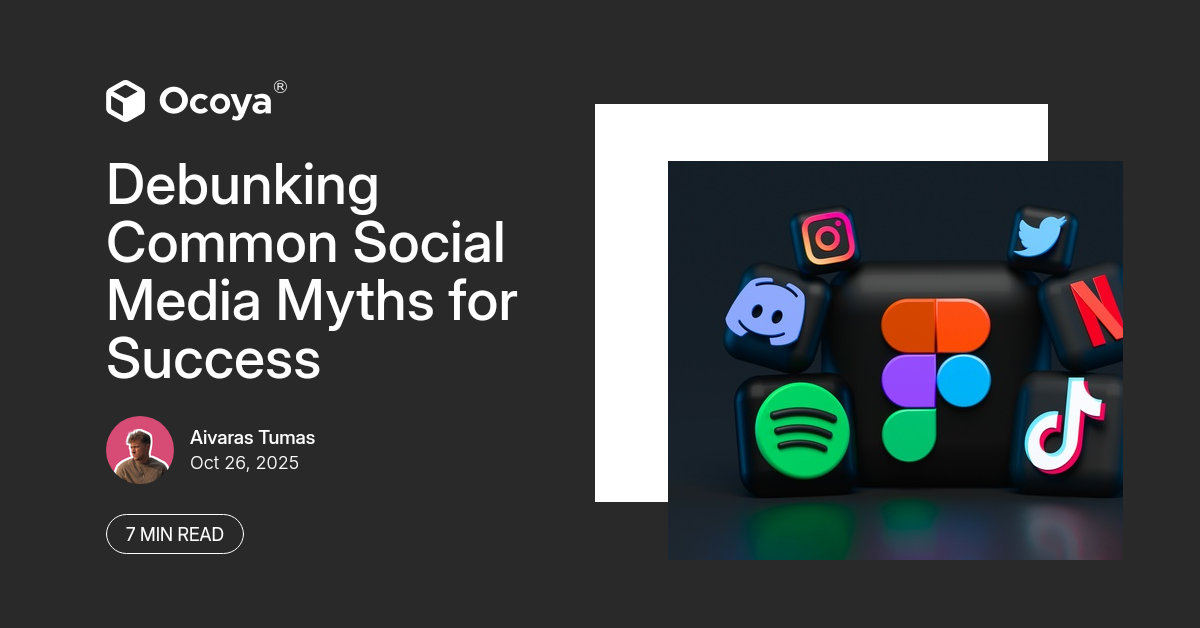
October 29, 2025
Marketing
Boost Your Retail Brand with Social Media Marketing

In today’s digital age, social media marketing has transformed from a mere trend to an essential cog in the machinery of any successful retail brand. The days when radio ads and print media ruled are long gone. Now, if you want your retail brand to stand tall, you need a robust social media marketing strategy. But why has social media marketing for retail brands become so crucial, and how can you harness its power? Let’s dive deep into the world of social media marketing, unveil its multifaceted advantages, and discover actionable strategies tailored for retail brands.
Understanding the Importance of Social Media Marketing for Retail Brands
Social media marketing in retail brands is not just about making a few posts on your brand's Facebook page or tweeting about a sale. It’s about creating a holistic, engaging, and interactive experience for your customers. Here’s why it’s crucial:
Increased Brand Awareness
Social media provides an unparalleled platform for increasing brand awareness. With billions of users across platforms like Facebook, Instagram, Twitter, and TikTok, your potential to reach a wider audience is immense. Crafting compelling content that resonates with your target market can significantly amplify your brand’s visibility.
Real-Time Engagement with Customers
One of the standout benefits of social media marketing for retail brands is the ability to engage with customers in real-time. Whether it’s responding to a query, addressing a complaint, or just thanking them for a purchase, quick and genuine interactions can foster a sense of community and loyalty.
Cost-Effective Marketing
Compared to traditional advertising methods, social media marketing offers a more cost-effective solution. Creating an account is free on most platforms, and even paid advertising on these platforms generally provides a high return on investment. You can start with a modest budget and scale as you see results.
Valuable Customer Insights
Social media platforms offer advanced analytics tools that can provide invaluable insights into customer behavior and preferences. Understanding what your customers like, when they are most active, and how they interact with your content can help you refine your marketing strategies for better results.
Building a Strong Social Media Marketing Strategy
Now that we understand the importance of social media marketing for retail brands, let’s explore how to build a solid strategy. A well-planned strategy is key to achieving your social media marketing goals.
Define Your Goals
The first step in building a social media strategy is to define your goals. What do you want to achieve? Is it increased brand awareness, higher sales, or more engagement? Your goals should align with your overall business objectives. Ensure they are Specific, Measurable, Achievable, Relevant, and Time-bound (SMART).
Know Your Audience
Understanding your audience is vital. Who are they, and what are their interests? Conduct market research to define your audience’s demographics, interests, and online behavior. This information will guide your content creation and platform selection.
Choose the Right Platforms
Not all social media platforms are created equal. Each platform has its unique user base and content style. For instance, Instagram is visual-centric and appeals to a younger audience, while LinkedIn is more professional. Choose platforms that align with your brand and where your target audience is most active.
Create Engaging Content
Content is the cornerstone of social media marketing. Create content that is engaging, informative, and visually appealing. Use a mix of content types such as images, videos, infographics, and written posts. Incorporate storytelling to connect with your audience emotionally.
Maintain Consistency
Consistency is key in social media marketing. Regularly posting high-quality content helps to keep your audience engaged and builds trust. Create a content calendar to plan and schedule your posts, ensuring a consistent flow of content.
Enhancing Customer Experience through Social Media
Your interaction with customers on social media plays a crucial role in shaping their experience with your brand. Here’s how to enhance customer experience:
Respond to Customer Queries Promptly
Quick responses to customer queries show that you value your customers' time and concerns. Aim to respond within 24 hours to maintain a positive impression.
Personalize Interactions
Personalizing your interactions can make customers feel valued. Use their names, refer to their past purchases, and address their specific concerns. Personalized interactions can foster a stronger connection.
Offer Exclusive Deals and Rewards
Reward your loyal customers with exclusive deals and rewards. Offering discounts, early access to sales, or special promotions can enhance customer loyalty and drive repeat business.
Encourage User-Generated Content
User-generated content (UGC) can be a powerful marketing tool. Encourage your customers to share their experiences with your products. Sharing their content on your social media profiles can create a sense of community and authenticity.
Measuring the Success of Your Social Media Marketing Efforts
It’s essential to measure the success of your social media marketing efforts to understand what’s working and what needs improvement. Use these metrics to gauge your performance:
Engagement Rate
Engagement rate measures how actively your audience interacts with your content. High engagement rates indicate that your content resonates with your audience. Track likes, comments, shares, and other interactions to understand your engagement level.
Reach and Impressions
Reach refers to the number of unique users who see your content, whereas impressions measure the total number of times your content is displayed. These metrics help you understand the visibility and spread of your content.
Conversion Rate
Conversion rate measures the percentage of users who take a desired action after seeing your content. This could be making a purchase, signing up for a newsletter, or any other goal. A high conversion rate indicates effective content and call-to-action.
Customer Sentiment
Customer sentiment analyzes how your audience feels about your brand. Monitor comments, reviews, and mentions to gauge the overall sentiment. Addressing negative feedback promptly can help maintain a positive brand image.
Return on Investment (ROI)
Calculate the ROI of your social media marketing efforts by comparing the revenue generated against the costs incurred. This helps you understand the financial effectiveness of your campaigns and enables you to allocate resources more efficiently.
The Role of Influencer Marketing in Retail
Influencer marketing has become a powerful component of social media marketing for retail brands. Partnering with influencers can help you reach a broader audience and build credibility. Here’s how to leverage influencer marketing:
Identify the Right Influencers
Select influencers whose audience aligns with your target market. Look for influencers who have a genuine connection with their followers and align with your brand's values.
Build Authentic Partnerships
Authenticity is crucial in influencer marketing. Collaborate with influencers who genuinely believe in your products. Authentic partnerships are more likely to resonate with their followers.
Track Influencer Campaign Performance
Measure the performance of influencer campaigns by tracking metrics such as engagement, reach, and sales. Use promo codes or unique links to attribute conversions to specific influencers.
Foster Long-Term Relationships
Building long-term relationships with influencers can yield better results over time. Consistent collaborations can reinforce your brand’s presence and credibility.
Leveraging Paid Advertising on Social Media
Organic reach on social media can be limited, and that’s where paid advertising comes into play. Here’s how to make the most of paid advertising:
Set Clear Objectives
Define clear objectives for your paid advertising campaigns. Whether it’s boosting brand awareness, driving traffic to your website, or increasing sales, clear objectives guide the campaign setup.
Target the Right Audience
Social media platforms offer advanced targeting options. Use demographic, geographic, and behavioral targeting to ensure your ads reach the right audience.
Create Compelling Ad Creatives
Invest in creating high-quality ad creatives that capture attention. Use eye-catching visuals, persuasive copy, and clear calls to action to engage your audience.
Monitor and Optimize
Regularly monitor the performance of your ads. Use the data to identify what works and what doesn’t. Optimize your campaigns by adjusting targeting, creatives, and budgets accordingly.
Customer Engagement Through Storytelling
Storytelling is a powerful tool for customer engagement. It helps create an emotional connection and makes your brand more relatable. Here’s how to incorporate storytelling into your social media strategy:
Share Your Brand’s Story
Every brand has a story. Share the journey of your brand, its values, and mission. Authentic stories resonate with customers and build a deeper connection.
Highlight Customer Stories
Share stories of your customers’ experiences with your products. User testimonials and reviews can add credibility and help prospective customers relate.
Use Visual Storytelling
Visual content, such as images and videos, can enhance storytelling. Use visuals to convey emotions, illustrate your brand’s journey, and showcase your products in action.
Incorporate Behind-the-Scenes Content
Showcasing behind-the-scenes content gives customers a glimpse into the authenticity of your brand. It humanizes your brand and fosters trust.
The Power of User-Generated Content (UGC)
User-generated content (UGC) is a goldmine for retail brands. Customers who create content around your brand provide free marketing and add authenticity. Here’s how to capitalize on UGC:
Encourage and Showcase UGC
Encourage your customers to share their experiences using your products. Create branded hashtags and feature user content on your social media profiles. Showcasing UGC demonstrates trust and builds a sense of community.
Host Contests and Challenges
Contests and challenges are effective ways to generate UGC. Encourage customers to participate by offering incentives such as discounts, freebies, or a chance to be featured on your official page.
Engage with UGC Creators
Engage with customers who create UGC by liking, commenting, and sharing their content. Acknowledgment and appreciation can foster loyalty and encourage more UGC.
Tracking and Analyzing Social Media Performance
Regularly tracking and analyzing your social media performance is essential to understand the effectiveness of your strategies. Utilize analytics tools to gather data and make data-driven decisions.
Key Metrics to Track
Focus on metrics such as engagement rate, reach, impressions, conversion rate, customer sentiment, and ROI. These metrics provide insights into how well your content performs and how it aligns with your goals.
Use Analytics Tools
Social media platforms offer built-in analytics tools. Platforms like Facebook Insights, Instagram Insights, and Twitter Analytics provide valuable data on your audience and content performance. Use these tools to monitor your progress.
Understand the Analytics
Data without understanding is just noise. Take the time to understand what the analytics reveal about your audience’s behavior. Identify patterns, trends, and areas for improvement.
Adjust Your Strategy
Use the insights gained from analytics to refine your strategies. Identify underperforming content and tweak it for better results. Continuously optimizing your approach ensures sustained success.
Integrating Social Media with E-commerce
The fusion of social media and e-commerce has created a seamless shopping experience for customers. Here’s how to integrate social media with e-commerce effectively:
Create Shoppable Posts
Platforms like Instagram and Facebook offer features that allow you to create shoppable posts. Tagging products in your posts enables customers to make purchases directly from your social media profiles.
Use Social Proof
Social proof, such as reviews and testimonials, can influence purchasing decisions. Highlight positive feedback and user-generated content to build trust and credibility.
Leverage Social Media Ads
Social media ads can drive traffic to your e-commerce site. Use targeted ads to reach potential customers, highlight products, and offer promotions to boost sales.
Provide Customer Support
Offer customer support through your social media channels. Addressing queries and concerns promptly enhances the shopping experience and reduces friction in the customer journey.
Enhancing Brand Loyalty through Social Media
Brand loyalty is crucial for long-term success. Cultivating brand loyalty through social media involves building trust, providing value, and maintaining consistent engagement.
Engage Regularly with Your Audience
Consistent engagement keeps your brand top of mind. Reply to comments, share user content, and participate in conversations. Regular interactions foster a sense of community and loyalty.
Offer Value through Content
Provide valuable content that meets your audience’s needs. Educational posts, how-to guides, and entertaining content can keep your audience engaged and appreciative.
Create Loyalty Programs
Loyalty programs reward repeat customers and encourage continued engagement. Offer incentives such as discounts, exclusive access, and special rewards to your loyal followers.
Continuously Improve
Constantly seek feedback and look for ways to improve. Showing your customers that you value their input and are committed to enhancing their experience builds loyalty.
Conclusion: Harness the Power of Social Media for Your Retail Brand
In conclusion, social media marketing is an indispensable tool for retail brands aiming to stay competitive and connect with their audience in meaningful ways. From increasing brand awareness and engagement to driving sales and building loyalty, social media platforms offer enormous potential. By understanding your audience, creating compelling content, engaging with customers, and leveraging the vast array of analytics and tools available, you can craft a powerful social media strategy that aligns with your business goals.
To further streamline your social media marketing efforts, consider using a comprehensive platform like Ocoya. Ocoya offers automated content creation, scheduling posts across multiple platforms, and detailed performance analytics, making it an ideal solution for businesses looking to enhance their online presence. Start your free trial with Ocoya today and take your social media marketing to the next level.
Key Takeaways
Increased brand awareness: Leverage social media platforms to reach a wider audience.
Engagement in real-time: Foster relationships through prompt and personalized interactions.
Cost-effective marketing: Utilize social media's free and paid options for greater ROI.
Content consistency: Maintain a constant flow of engaging content.
Analytical insights: Use analytics tools to gauge performance and adapt strategies.
Influencer collaborations: Partner with influencers to extend your reach.
Paid advertisements: Invest in targeted ads to boost visibility and sales.
User-generated content: Encourage and showcase UGC to build authenticity.
Elevate your social media marketing for retail brands by utilizing tools like Ocoya. Sign up for a free trial today and see how it can transform your brand's social media presence.

Continue Reading
The latest handpicked blog articles.



.svg)

.svg)






